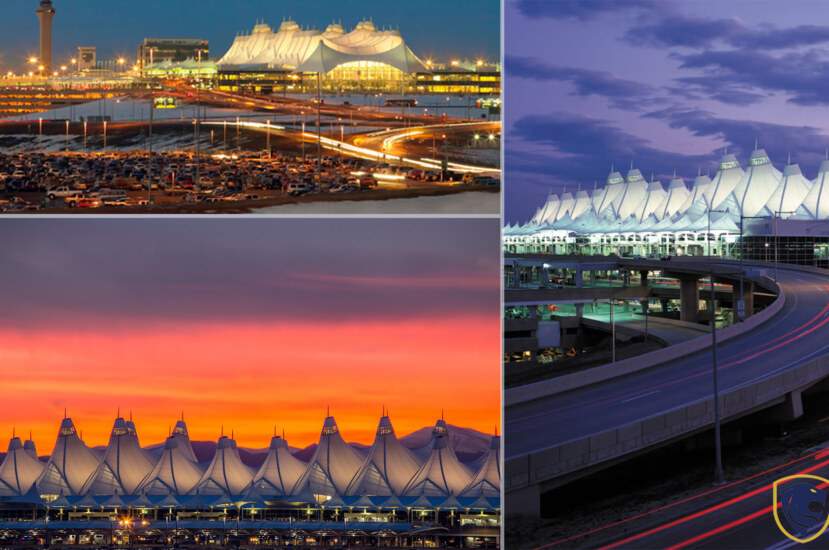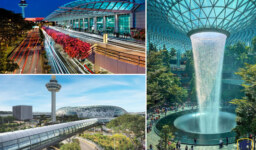A major international airport in the Western United States, Denver International Airport, often referred to by its local abbreviation as DIA, serves primarily the metropolitan area of Denver, Colorado. Additionally, it is part of a larger urban corridor known as the Front Range Urban Corridor. It is the second biggest airport in the world, behind King Fahd International Airport. It spreads over a land size of 33,531 acres. With a length of 16,000 feet Runway, 16R/34L is the seventh-longest runway in the world. Also, it is the longest runway for public use in North America. Its’ only connection to the rest of the city of Denver is on its southwest side connecting a strip of neighborhoods.
Denver International airport, which opened in 1995, has non-stop service from 25 different airlines to over 215 locations in America, Europe, and Asia. Furthermore, Denver became the fourth airport in the United States to reach this milestone. Located at the airport, Southwest Airlines is the airline’s primary operational base. There are nearly 35,000 workers at the airport, making it one of Colorado’s largest employers. The airport is situated on the western side of the Great Plains, close to the Front Range of the Rocky Mountains.
History of Denver International Airport

History of Denver International Airport
Due to Denver’s great location in the center of all continents, this airline hub has historically been one of the busiest airports in the US. Many airlines utilized the former Stapleton International Airport. By the 1960s, it was the sixth busiest airport in the US. However, Stapleton was congested, with limited ability to accommodate extra flights and runways that were too near to one another. This resulted in lengthy waits in poor weather that would affect traffic across the country.
The Denver Area Council of Governments looked at potential locations for a new regional airport north and east of Denver from 1980 to 1983. Federico Pea ran for mayor of Denver in 1983 while advocating for the development of Stapleton on the grounds of the Rocky Mountain Arsenal. Although the initiative received widespread support, Adams County officials nearby vowed to sue him over noise concerns.
Adams County voters agreed on the plan of establishing this airport in 1988. Due to its distance from the city center, the plan was regarded with considerable mistrust. However, seeing the value of a Denver aviation hub for the country’s transportation network, the federal government contributed $500 million to the construction of the new airport. Bonds were used to covering the remaining costs. They were about to be repaid using airline ticket prices. In September 1989, the foundation was officially laid.
The mega project was handed over to Mayor Wellington Webb two years later, with an opening date of October 29, 1993, at the time.
Terminal

Terminal
Elrey Borge Jeppesen, a pioneer in aviation safety, is honored by The Jeppesen Terminal. It is a single terminal with three widely separated middle concourses. By the end of 2022, 179 gates were open on the three midfield concourses. Further, both the subterranean rail system, which serves all three concourses, and a pedestrian bridge leading straight from the terminal building connect passengers to Concourse A. Concourses B and C are only accessible by rail.
Concourse A is where all multinational arrivals without customs pre-clearance are handled. This concourse also features four 3-jetway international gates. Those can accommodate ADG Group VI aircraft, including the world’s two largest commercial aircraft, the Airbus A380 and Boeing 747-8.
Architecture and Design
Curtis Fentress worked relentlessly to provide an inventive solution for Denver’s passenger terminal. This terminal was more reasonably priced and quicker to construct. Most importantly, it had an iconic design. He had only three weeks to come up with a fresh idea. The city wanted both a symbol and a gateway. They needed a structure that would be both aesthetically appealing and useful.
After 35 years, airports had become “people processors,” with crowded, maze-like hallways and dim fluorescent lighting inside. Fentress’ design broke through this ceiling. The traditional “warehouse” architectural approach shifted away from the demands of the passengers.

Architecture and Design
Curtis Fentress, an employee of I.M. Pei and the leader of his own reputable business, resolved to reverse this tendency after researching airport design for his master’s thesis.
They have stripped all the mechanicals off the roof. Moreover, this allowed them to design a superlight, cutting-edge construction with a light-filled canopy. By doing this, the airport was able to save thousands of tons of steel. In addition, it saved nine months off the construction timetable.
The iconic design was inspired by the snow-capped Rocky Mountains
Colorado’s artistically crafted roof cover recalls images of the spectacular, snow-capped Rocky Mountains, hardy pioneer settlers’ covered wagons, and Native American teepees. This airport started to represent a city and a region standing out from every other construction in the city. Travelers from all over the world have come to recognize and appreciate the terminal’s peaked roof. Moreover, the terminal came in at number four on the American Institute of Architects list of “Favorite American Architecture” monuments in a survey of the general population.
The iconic design was inspired by the snow-capped Rocky Mountains
Fentress entered the world of airport design thanks to Denver International Airport’s transformative approach. His airport terminals are renowned for being easy to use. In addition, the efficient designs, calmness, and downright beauty of his designs are truly unforgettable. Furthermore, Fentress Architects has established itself as a world authority in cutting-edge and sustainable airport architecture. This was thanks to its more than 20 years of expertise designing 4.8 million square meters of airport space valued at USD$13.5 billion and its reputation for quality.
Facilities
Hotels
The Westin Denver International Airport has its own 519-room hotel and convention facility. It is a short distance from the main terminal. Moreover, it is close to the Transit Center, which provides shuttle and public transportation options, including the A Line commuter rail, to downtown Denver.

Denver international airport
Pet Relief Areas
At DEN, each concourse now has a special toilet just for furry passengers. In addition, there is one outside Jeppesen Terminal as well. Service animals and other pets have a cozy and pleasant place to take care of before or after a trip thanks to the indoor pet relief facilities.

Pet Relief Areas
Information Assistance
Once you talk to one of their consultants, you’ll feel much better. You can even get help finding your way around the airport.
Nursing Rooms

Nursing Rooms
DEN provides moms with a cozy, private area where they may breastfeed their infants. There are three nursing rooms. While traveling, each room offers a calm setting for nursing or pumping.
Shopping at Denver International Airport
Shopping involves more than simply buying necessities. Beautiful jewelry creations, seasonally appropriate clothing, tough outdoor gear, and an abundance of artwork are all ready to wow you as you approach your gate. Moreover, DEN strive to make the entire buying experience enjoyable.

Shopping at Denver International Airport
Colorado Originals which is located at gate A has Gifts & Souvenirs, Kiosk, Personal Care, and Pre-packaged Foods available. In addition, Pia Collection is a place in DEN to buy Hair Accessories. Pia Collection Jewelry is the perfect place to visit if you want to buy Gifts & Souvenirs and Jewelry. Moreover, there are electronics available at Fix ‘N Fly. There are several shops located in DEN which you can witness once you arrived there.




